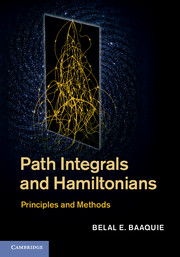Baaquie, Belai E. (2004). Quantum Finance. Cambridge, UK: Cambridge University Press.
Baaquie, B. E. (2009). Interest rates in quantum finance: The Wilson expansion and Hamiltonian. Phys. Rev. E, 80(Oct), 046119.
Baaquie, Belal E. (2010). Interest Rates and Coupon Bonds in Quantum Finance. Cambridge, UK: Cambridge University Press.
Baaquie, B. E. (2013a). Financial modeling and quantum mathematics. Computers and Mathematics with Applications, 65, 1665–1673.
Baaquie, B. E. (2013b). Statistical microeconomics. Physica A, 19(1), 4400–4416.
Baaquie, Belal E. (2013c). Action with acceleration I: Euclidean Hamiltonian and path integral. Int. J. Mod. Phys. A, 28, 1350137.
Baaquie, Belal E. (2013d). Action with acceleration II: Euclidean Hamiltonian and Jordan blocks. Int. J. Mod. Phys. A, 28, 1350138.
Baaquie, Belal E. (2013e). The Theoretical Foundations of Quantum Mechanics. New York, USA: Springer.
Baaquie, B. E. and Martin, F. (2005). Quantum psyche: Quantum field theory of the human psyche. NeuroQuantology, 3(5), 7–42.
Baaquie, B. E. and Yang, Cao. (2014). Option volatility and the acceleration Lagrangian. Physica A, 393, 337–363.
Baaquie, Belal E., Yang, Cao, Lau, Ada, and Tang, Pan (2012). Path integral for equities: Dynamic correlation and empirical analysis. Physica A, 391(4), 1408–1427.
Ballentine, L. E. (1998). Quantum Mechanics: A Modern Development. Singapore: World Scientific.
Bell, J. (2004). Speakable and Unspeakable in Quantum Mechanics. 2nd edn. Cambridge, UK: Cambridge University Press.
Bender, Carl M. and Mannheim, Philip D. (2008a). Exactly solvable PT-symmetric Hamiltonian having no Hermitian counterpart. Phys.Rev. D, 78(Jul), 025022.
Bender, Carl M. and Mannheim, Philip D. (2008b). No-ghost theorem for the fourth-order derivative Pais-Uhlenbeck oscillator model. Phys. Rev. Lett., 100(Mar), 110402.
Bender, C. M. and Mannheim, P. D. (2010). PT symmetry and necessary and sufficient conditions for the reality of energy eigenvalues. Phy. Lett. A, 1616.
Bender, Carl M. and Mannheim, Philip D. (2011). PT-symmetry in relativistic quantum mechanics. Phys. Rev. D, 84(Nov), 105038.
Creutz, M. and Freedman, B. (1981). A statistical approach to quantum mechanics. Annals of Physics, 132, 427–462.
Das, A. (2006). Field Theory: A Path Integral Approach. Singapore: World Scientific.
Dirac, P.A.M. (1964). Lectures on Quantum Mechanics. New York: Belfer Graduate School of Science Monographs Series 2.
Dirac, P. A. M. (1999). The Principles of Quantum Mechanics. 4th edn. Oxford, UK: Oxford University Press.
Feynman, R.P. (1948). Space-time approach to non-relativistic quantum mechanics. Rev. Mod Phys, 20(Apr), 367–387.
Feynman, R.P. and Hibbs, A.R. (1965). Quantum Mechanics and Path Integrals. New York, USA: McGraw-Hill.
Fontanini, Michele and Trodden, Mark. (2011). Tackling higher derivative ghosts with the Euclidean path integral. Phys.Rev. D, 83(May), 103518.
Gottfried, K. and Yan, T-.M. (2003). Quantum Mechanics. 2nd edn. Heidelberg, Germany: Springer.
Haven, E. and Khrennikov, A. (2013). Quantum Social Science. Cambridge, UK: Cambridge University Press.
Hawking, S. W. and Hertog, Thomas (2002). Living with ghosts. Phys. Rev. D, 65(May), 103515.
Jones, H.F. and Rivers, R.J. (2009). Which Green functions does the path integral for quasi-Hermitian Hamiltonians represent?Physics Letters A, 373.
Kandirmaz, N. and Sever, R. (2011). Path integral solution of PT-/non-PT-symmetric and non-Hermitian Hulthen potential. Acta Polytechnica, 0(0), 38–42.
Kardar, M. (2007). Statistical Theory of Fields. Cambridge, UK: Cambridge University Press.
Kleinert, H. (1986). Path integral for second derivative Lagrangian. J. Math. Phy., 27(Dec), 3003–3013.
Kleinert, H. (1990). Path Integrals in Quantum Mechanics, Statistics, and Polymer Physics, and Financial Markets. Singapore: World Scientific.
Landau, L. D. and Lifshitz, L. M. (2003). Quantum Mechanics: Non-Relativistic Theory. Third edn. Vol. 3. Amsterdam, Holland: Elsevier Science.
Mannheim, P.D. (2011a). Comprehensive solution to the cosmological constant, zero-point energy, and quantum gravity problems. Gen. Rel. Gravitation, 43, 703–750.
Mannheim, P.D. (2011b). Making the case for conformal gravity. Foundations of Physics, 37, 532.
Mannheim, Philip D. and Davidson, Aharon (2000). Fourth order theories without ghosts. arXiv preprint hep-th/0001115.
Mannheim, P. D. and Davidson, A. (2005). Dirac quantization of the Pais-Uhlenbeck fourth order oscillator. Phys. Rev. A, 71(Apr), 042110.
Mostafazadeh, A. (2002). Pseudo-Hermiticity versus PT-symmetry III: Equivalence of pseudo-Hermiticity and the presence of antilinear symmetries. Journal of Mathematical Physics, 43(8), 3944–3951.
Papon, P., Leblond, J., and Meije, P. H.E. (2002). The Physics of Phase Transitions. New York, USA: Springers.
Phillips, R., Kondev, J., Theriot, J., and Garcia, H. (2008). Physical Biology of the Cell. New York, USA: Garland Science.
Polyakov, A. M. (1987). Gauge Fields and Strings. New York, USA: Harwood Academic Publishers.
Risken, M. (1988). The Fokker-Planck Equation. Heidelberg, Germany: Springer.
Rivers, R.J. (2011). Path integrals for Pseudo-Hermitian Hamiltonians. International Journal of Theoretical Physics, 50, 1081–1096.
Scholtz, F. G., Geyer, H. B., and Hahne, F. J. W. (1992). Quasi-Hermitian operators in quantum mechanics and the variational principle. Annals of Physics, 213(1), 74101.
Simon, J.Z. (1990). Higher-derivative Lagrangians, nonlocality, problems, and solutions. Phys. Rev. D, 41(Jun), 3720–3733.
Stapp, H. P. (1963). The Copenhagen interpretation. Am. J. Phys., 40(8), 1098.
Vanderbilt, D. (1990). Soft self-consistent pseudopotentials in a generalized eigenvalue formalism. Phys.Rev.B, 41(Apr), 7892–7895.
Wang, Q., Chia, S., and Zhang, J. (2010). PT symmetry as a generalization of Hermiticity”. Journal of Physics, A, 43, 295301.
Weinberg, S. (2013). Lectures on Quantum Mechanics. Cambridge, UK: Cambridge University Press.
Wilson, K. G. (1969). Non-Lagrangian models in current algebra. Physical Review, 179, 1499–1512.
Wilson, Kenneth G. (1983). The renormalization group and critical phenomena. Rev. Mod. Phys., 55(Jul), 583–600.
Wilson, K. G. and Zimmermann, W. (1972). Operator product expansions and composite field operators in the general framework of quantum field theory. Communications in Mathematical Physics, 24(2), 87–106.
Witten, E. (1989). Quantum field theory and Jones polynomial. Communications in Mathematical Physics, 121(3), 351–399.
Wu, T.T. and Yu, M.L. (2002). Theory and application of Fermi pseudo-potential in one dimension. Journal of Mathematical Physics, 43(12), 5949.
Yang, Cao (2012). Higher Derivative Models and Libor Market Model in Quantum Finance. Ph.D. thesis, National University of Singapore, Department of Physics, 2 Science Drive 3, Singapore 117551.
Zinn-Justin, J. (1993). Quantum Field Theory and Critical Phenomenon. Oxford, UK: Oxford University Press.
Zinn-Justin, J. (2005). Path Integrals in Quantum Mechanics. Oxford, UK: Oxford University Press.



